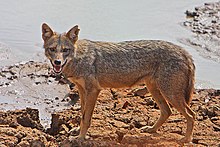Jackals
| Jackal | |
|---|---|
 |
|
| Golden jackal (Canis aureus) | |
| Scientific classification | |
| Kingdom: | Animalia |
| Phylum: | Chordata |
| Class: | Mammalia |
| Order: | Carnivora |
| Family: | Canidae |
| Genus: |
Included in Canis Linnaeus, 1758 |
| Species | |
|
Golden jackal, Canis aureus |
|
 |
|
Golden jackal, Canis aureus
Side-striped jackal Canis adustus
Black-backed jackal Canis mesomelas
Jackals are medium-sized omnivorous mammals of the genus Canis, which also includes wolves and the domestic dog. While the word "jackal" has historically been used for many small canids, in modern use it most commonly refers to three species: the closely related black-backed jackal and side-striped jackal of sub-Saharan Africa, and the golden jackal of south-central Eurasia, which is more closely related to other members of the genus Canis.
Jackals and coyotes (sometimes called the "American jackal") are opportunistic omnivores, predators of small- to medium-sized animals and proficient scavengers. Their long legs and curved canine teeth are adapted for hunting small mammals, birds, and reptiles, and their large feet and fused leg bones give them a physique well-suited for long-distance running, capable of maintaining speeds of 16 km/h (9.9 mph) for extended periods of time. Jackals are crepuscular, most active at dawn and dusk.
Their most common social unit is a monogamous pair, which defends its territory from other pairs by vigorously chasing intruding rivals and marking landmarks around the territory with their urine and feces. The territory may be large enough to hold some young adults, which stay with their parents until they establish their own territories. Jackals may occasionally assemble in small packs, for example, to scavenge a carcass, but they normally hunt either alone or in pairs.
...
Wikipedia
